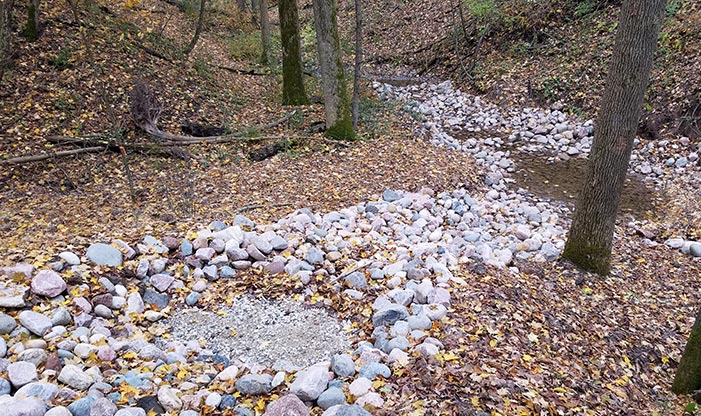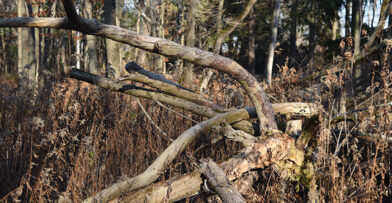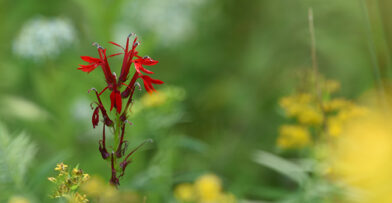If you visited the Center late this summer, you likely encountered a few trail closures, caught a glimpse of heavy equipment, or heard the din of active construction on the Stormwater Wetland & Ravine Restoration Project. Now that the dust has settled, the landscape around the North Ravine has been transformed. Two new ponds are ready to foster new life, and the ravine itself has been stabilized and fortified against future erosion.
Stormwater Management
Water lies at the heart of the Stormwater Wetland & Ravine Restoration Project. In the early 1800s, the land that became Schlitz Audubon was deforested and divided into farm plots. Over time, the loss of native vegetation compounded by heavy agricultural use compromised the land’s ability to absorb stormwater. This water instead began to cut what is now the North Ravine as it flowed to Lake Michigan, taking what we estimate to be more than 2,000,000 cubic feet of soil with it since the area was first surveyed in 1835. This is the equivalent of nearly 24 quad-axle dump trucks loads of soil being washed into the lake every year for the last 184 years!
Through the Stormwater Wetland & Ravine Restoration Project, berms have been created to flank the ravine to capture water upland instead of allowing it to run unchecked to the lake. This also creates more wetland habitat for native plants and animals, as well as more educational hotspots for visitors. With a footprint of more than 20 acres, the project will capture up to 7 million gallons of stormwater every year.
When you experience the new habitats, you may not see stormwater management. What you will see are new ponds, more temporary wetlands flanking boardwalk trails, and the beautiful regenerative stormwater conveyance system (RSC). RSC is a forward-thinking design that incorporates natural stream channel cascade aesthetics to convey and purify water as it flows into the ravine. When you explore the area, look for a rocky step-pool near the northernmost pond. If you’re lucky, you’ll hear the calming sound of water bubbling over rocks (water will only flow here intermittently), and you’ll know you’re in the right place.
Less conspicuous than the work on the berms, ponds, and ravine, but just as important, is the post-construction habitat restoration that also started in summer 2019. Approximately 10,000 seedlings, like Pennsylvania sedge, marsh blazing star, and cardinal flower, and 700 shrubs, such as American elderberry and black cherry, have already been planted, as have 60 bur oak and swamp white oak. Volunteers played a huge role in this project, and there is more work to come! More than 25,000 native seedlings, shrubs, and trees will be planted in the project area before the end of 2020.
Next Steps: Providing Access
Access for all visitors is a critical next step. Construction has already started on new trails and boardwalks that will wind throughout the project area, giving visitors an immersive look at the new habitats. Look for initial segments to open in spring of 2020, with accessibility modifications and additional construction to continue through 2021.
Generous donations from the donor community will help us build the Water Path, comprised of crushed granite trail, boardwalks, and teaching decks that will give visitors unparalleled access to these enhanced habitats. Plans call for more than half-mile of new trail, and our construction goal for 2020 is to compete approximately half, or 1,500 linear feet, of the trail.
If you would like to learn more about the Water Path Trail, the Stormwater Wetland & Ravine Restoration Project, or how you can get involved, please contact Carrie Becker, Director of Development, at (414) 352-2880 x122 or cbecker@schlitzaudubon.org.
Thank You to our Stormwater Wetland & Ravine Restoration Project Funders
Vital partners throughout the Greater Milwaukee community and beyond rallied to support conservation by funding the Stormwater Wetland & Ravine Restoration project. Supporters of the project include Brico Fund, National Fish and Wildlife Foundation, Milwaukee Metropolitan Sewerage District, Fund for Lake Michigan, Freshwater Future, Brookby Foundation, Pentair Foundation, an anonymous corporate donor, and an anonymous private donor.


